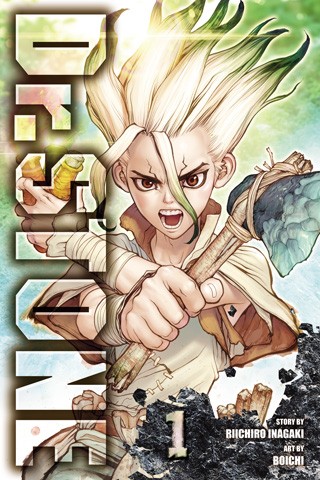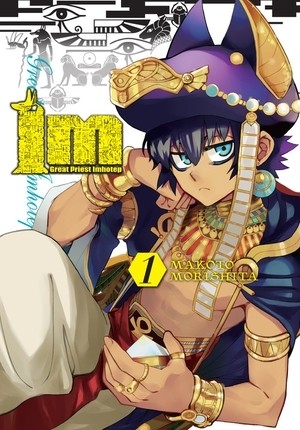While the titular hero of Dr. Stone is Senku, who earns that sobriquet as he crafts the cure for the petrification epidemic which froze human history, human civilization, and, in short, all human life, its point-of-view protagonist is Taiju Oki, a muscular youth well-suited to playing the part of the everyman, and thus better suited as the empty vessel for the reader’s vicarious enjoyment of Riichiro Inagaki and Boichi’s catastrophe / survival science fiction story.
While Senku is a combination Sherlock Holmes / Doctor / MacGyver capable of crafting all the goodies of pre-industrial civilization from an ample store of calcium carbonate, Taiju is less Dr. Watson than work horse, capable of anything the creators set his mind to doing, such as dragging two companions on a raft through a moving stream. While horsepowered nearly to superhuman propensities, Taiju is nonetheless the more relatable and believable of the two.
For instance, Dr. Stone opens not with a gratuitous opportunity to exercise Taiju’s fantastic strength, and prove it worthy of this science fiction fable, but with a confession of love worthy of a slice of life manga—which is, unfortunately for Taiju, put on a thirty century hiatus by the petrification wave. It is only after his awakening in the forty-eighth century that Taiju accrues feats worthy of a shonen manga hero, although he’s still fixated on cracking his girlfriend Yuzuhira’s stone sheath so that he can finally spit out the pent-up longing that he’s repressed through his teenage years, not to mention the centuries of his petrified dormancy during which he perpetuated his continuity of mind by a fusion of mulish stubbornness and “love knows no bounds.” (By comparison, superscientist Senku stays awake by keeping such a perfect count of the passing seconds that an atomic clock would envy it.)
While Taiju is no Dr. Watson, there is nonetheless a Holmesian dynamic between the coprotagonists, and this is perhaps due to the fact that Dr. Stone is not only science fiction, but a novel of scientific detection, in which the superscientist must reverse engineer not only the cure, but the rebirth of human civilization, by penetrating their mysteries. Similarly, while Senku is no Dr. Who, it is only for lack of a Tardis, as Taiju and Yuzuhira make excellent emptyheaded companions, and he soon gets his Master in the form of teenaged archnemesis Tsukasa.
Initially pointed out as a particularly famous statue who excelled in martial arts, Tsukasa is Senku’s first successful revivification because in their first attempt to resuscitate Yuzuhiira, they are interrupted by lions, and by virtue of lightning-fast shonen manga logic, Taiju and Senku knock heads and decide to give Tsukasa a whirl. While Tsukasa demolishes the lions with his Looney Tunes martial arts prowess, he soon demonstrates nastier quirks, such as a tyrannical appetite for elbow room which leads him to smash other petrified humans, which he calls “thinning the herd.” Tsukasa soon supplants the petrification wave as the antagonist of the series, and Dr. Stone Volume 1 ends with Senku, Taiju, and Tuzuhira questing for the components of gunpowder, called “the greatest invention of the human race.”
While I had some quibbles–there’s a reason we remember Johannes Gutenerg, but not the inventor of gunpowder—Dr. Stone is a fast-paced, straightforward action adventure story that also adheres to some of the strictest definitions of science fiction. Unlike much of what passes for science fiction in manga (and out of it), you could not give Dr. Stone a change of scene and time without completely wrecking the story. Whereas you could tell the story of Astra Lost in Space in the fourteenth century, with sailing ships taking the place of spaceships, islands that of planets, and the rule of primogeniture that of the paternity registry, the novum of Dr. Stone—the petrification wave—is inextricably worked into the plot. (The preceding sentences paraphrase some of Darko Suvin’s ideas on science fiction.) You couldn’t simply remove these characters to a desert island and tell the same story; that Robinson Crusoe story might resemble their reconstruction of civilization in part, but the catastrophic angst of Dr. Stone is unique in that while the goal in both stories would be survival, Dr. Stone suggests that its heroes are working not only for survival of the individual, but survival of the species, and on top of that, the rebirth of an annihilated human culture, not only its science and architecture, but its amusements (the future of anime is specifically referenced as being one of the things hanging on their reconstructive efforts).
Not that Dr. Stone is the best manga science fiction I’ve ever read; for that matter, it isn’t even in my top twenty reads this year. That said, while Dr. Stone isn’t the next Goodnight Punpun or Death Note, it is an entertaining and amusing comic, and I recommend Dr. Stone to readers looking for good comic book stories.
Dr. Stone arrives on shelves on September, 2018. You can also buy a copy in print or digital through Viz Media.
Viz Media sent the review copy.


